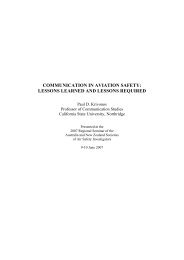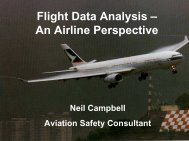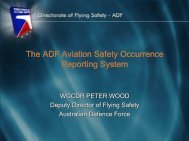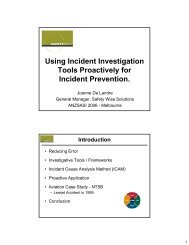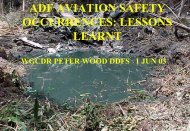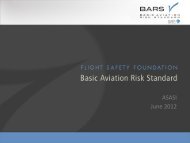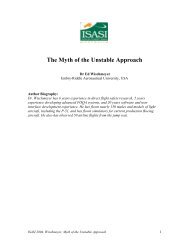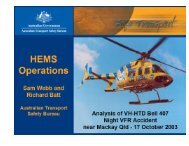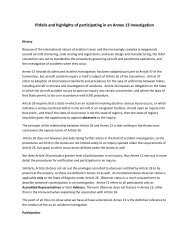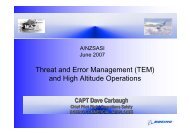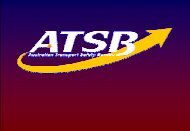Evidence Based Training For Airline Pilots - Patrick Murray.pdf - ASASI
Evidence Based Training For Airline Pilots - Patrick Murray.pdf - ASASI
Evidence Based Training For Airline Pilots - Patrick Murray.pdf - ASASI
Create successful ePaper yourself
Turn your PDF publications into a flip-book with our unique Google optimized e-Paper software.
ANZSASI 2012 Sydney 1 – 3 June<br />
<strong>Evidence</strong> <strong>Based</strong> <strong>Training</strong><br />
<strong>For</strong> <strong>Airline</strong> <strong>Pilots</strong><br />
<strong>Patrick</strong> <strong>Murray</strong><br />
EBT Project Team
APATS BANGKOK 20 / 21 Sep 2011
APATS BANGKOK 20 / 21 Sep 2011
Hull Loss<br />
per million departures<br />
1st generation:<br />
Early jet<br />
2nd generation:<br />
2 nd jet generation<br />
3rd generation:<br />
Glass-cockpit<br />
Nav display<br />
FMS<br />
4th generation:<br />
FBW<br />
Flight Envelope<br />
Protection<br />
1 st generation<br />
All aircraft<br />
4 th generation<br />
3 rd generation<br />
2 nd generation<br />
Years Of Operation<br />
Source: Airclaims, Airbus
Mandatory Items<br />
‣ Flight Preparation<br />
‣ Before take-off checklist<br />
‣ Engine failure between V1 and V2<br />
‣ Rejected take-off before reaching V1<br />
‣ Instrument departure and arrival procedures<br />
‣ Engine-out Precision Approach to minima<br />
‣ Non-Precision approach to MDA<br />
‣ Go-Around 1 engine-out at DA<br />
‣ Landing critical engine inoperative
The Problem<br />
‣ By regulation flight crew training and checking is based<br />
on events, many of which have become highly<br />
improbable in modern aeroplanes.<br />
‣ <strong>Training</strong> programmes are consequently saturated with<br />
items that may not necessarily mitigate the real risks<br />
or enhance safety in modern air transport operations.<br />
‣ Automation control, flightpath guidance and monitoring<br />
not currently adequately considered in regulations
Black Swans<br />
When people and complex systems interact, there will<br />
always be an infinite number of possible outcomes
Sioux City – “Black Swan”
Sioux City - Black Swan<br />
QF 32 – A380 “Black Swan”
QF 32 - A380 “Black Swan”<br />
“The pilots were inundated with 54 computer<br />
messages alerting them of system failures or<br />
impending failures” during the two-hour airborne<br />
drama with more than 450 passengers aboard”<br />
said Capt Woodward, Vice - President of the<br />
Australian and International <strong>Pilots</strong> Association<br />
Capt Woodward said<br />
“I don't think any crew in the<br />
world would have been trained to<br />
deal with the amount of different<br />
issues this crew faced”<br />
www.news.com.au/travel/qantas
Repetitive &<br />
foreseeable<br />
Unique &<br />
unforeseeable<br />
<strong>Evidence</strong><br />
No evidence<br />
What we<br />
know<br />
What we don’t<br />
know
‣ LOSA Archive data reports<br />
‣ Top 10 issues<br />
‣ Error Management effectiveness<br />
‣ Flight Data Analysis studies<br />
‣ Accident / Incident analyses<br />
‣ Studies on AQP / ATQP <strong>Airline</strong> results<br />
‣ Skill Decay & Skill Retention Studies<br />
‣ Flight deck Automation studies<br />
‣ STEADES<br />
‣ Airbus Special FDA Reports<br />
‣ Boeing Pilot Survey
Methods of Analysis – General<br />
‣ Results from the individual analyses are:<br />
‣Distilled into singular declarative sentences<br />
‣ Entered in Findings database<br />
‣ Linked to:<br />
‣ Data Report Objectives<br />
‣ Phases of Flight<br />
‣ Data Sources<br />
‣ Topics discussed in the Conclusion<br />
‣ Context and Comments surrounding findings
Methods of Analysis – General<br />
‣ Findings data base enables:<br />
‣Partitioning the data in various practical ways.<br />
‣Managing multiple results from different sources<br />
‣View clear support of conclusions<br />
‣Traceability from conclusion back to source data and<br />
vice versa
Some Findings - Priorities<br />
‣ Priorities considered across aircraft generations<br />
‣ One size does not fit all (Major differences across generations)<br />
‣ Prioritisation validated by evidence<br />
‣ Threat & Error Management = potential training scenarios
Threat and Error Management<br />
‣ Threats & Errors considered across Flight Phases specific to<br />
aircraft generation<br />
‣ “Trainability” a key feature<br />
‣ Need to develop more effective monitoring and intervention<br />
‣ “In – seat” training by instructors in certain exercises
Generation 4 Provisional “A List” (∂ẞ order)<br />
‣ Adverse Weather<br />
‣ Automation Management<br />
‣ Compliance<br />
‣ Go-Around Management<br />
‣ Manual Aircraft Control<br />
‣ Monitoring, cross checking, error detection<br />
‣ Unstable Approach (recognition and management)
Typical Recurrent EBT Module<br />
1<br />
2<br />
3<br />
Evaluation Phase<br />
Manouvres <strong>Training</strong><br />
Phase<br />
Scenario <strong>Based</strong><br />
<strong>Training</strong> Phase<br />
Objective<br />
• Assess competence<br />
• Identify training needs<br />
• Validate training<br />
system performance<br />
• Train maneuver skills to<br />
proficiency.<br />
• Validate system<br />
performance and skill<br />
decay.<br />
• Manage the critical threats<br />
according to evidence<br />
• Improve competency to<br />
manage foreseen &<br />
unforeseen threats<br />
Conduct<br />
• Line orientated<br />
One or more<br />
occurrence<br />
• Assessment of one or<br />
more KSA Competency<br />
Elements<br />
• Sequence of deliberate<br />
actions to achieve a<br />
prescribed flight path<br />
• E.g. RTO, EF V1, OEI<br />
APP, OEI GA, Emer.<br />
Descent<br />
• Line orientated flight<br />
scenarios<br />
• One or more predictable or<br />
unpredictable threats
EBT Program Implementation
EBT Development Timeline<br />
Applicability<br />
Q4 2012 <br />
PANS-TRG Draft<br />
EBT Manual Draft<br />
Dec 2010<br />
PANS-TRG<br />
Final Draft<br />
21 Mar 2011<br />
ICAO EBT Manual<br />
Final Draft<br />
31 Mar 2011<br />
EBT<br />
Gen4<br />
31 July 2011<br />
EBT Analysis<br />
Complete<br />
15 Nov 2011<br />
Final Data<br />
Report<br />
Q1 2012<br />
ICAO<br />
Final Review<br />
Q2 2012<br />
ICAO<br />
Review<br />
Dec 2010 - Mar 2011<br />
EBT Phase 2<br />
Type Ratings<br />
Jul 2012
Proof of Concept Phase<br />
‣ Adoption of EBT principles – Step 1 (existing rules)<br />
‣ Baseline or Enhanced Programme<br />
‣ Phase 1 (Recurrent)<br />
‣ Emirates (Feb 2011) – GCAA<br />
‣ Cathay Pacific (Dec 2011) - HK CAD<br />
‣ Dragonair (April 2011) – HK CAD<br />
‣ Qantas (2012) – CASA<br />
‣ Virgin Australia (2012) CASA<br />
‣ Air France (2012) – DGAC<br />
‣ Air Transat (TBD) - Trspt Canada<br />
‣ Qatar Airways (TBD) - GCAA<br />
‣ Phase 2 (Type Rating)<br />
‣ British Airways – UK CAA
Improved design<br />
& reliability<br />
Train skills to<br />
manage real<br />
threats<br />
Examine the<br />
<strong>Evidence</strong><br />
New Paradigm for<br />
<strong>Training</strong><br />
Train to<br />
competency
ANZSASI 2012 Sydney 1 – 3 June<br />
Thank you for your attention<br />
<strong>Patrick</strong> <strong>Murray</strong><br />
EBT Project Team<br />
patrick.murray@griffith.edu.au



